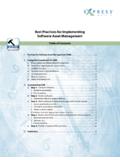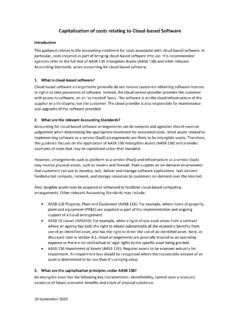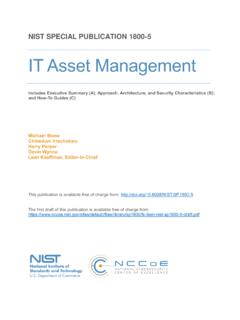Transcription of Asset Management Programs for Stormwater and …
1 Asset Management Programs for Stormwater and Wastewater Systems: Overcoming Barriers to Development and Implementation March 6, 2017 Prepared for: Environmental Protection Agency Office of Science and Technology Ariel Rios Building 1200 Pennsylvania Avenue, N. W. Washington, DC 20460 and Environmental Protection Agency Region 9 75 Hawthorne Street San Francisco, CA 94105 Prepared by: PG Environmental 570 Herndon Parkway, Suite 500 Herndon, VA 20170 EPA Contract No. EP-C-14-003 Asset Management Programs for Stormwater and Wastewater Systems: Overcoming Barriers to Development and Implementation March 6, 2017 i ABBREVIATIONS AND ACRONYMS AMP Asset Management program AWWA American Water Works Association CIP Capital Improvement Plan CMMS computerized maintenance Management system CMOM Capacity, Management , operation, and maintenance CUPSS Check Up Program for Small Systems CWA Clean Water Act EPA Environmental Protection Agency GIS geographic information system GPS Global Positioning System IWA-WSAA International Water Association Water Services Association of Australia MS4 municipal separate storm sewer system NPDES National Pollutant Discharge Elimination System RAMCAP Risk Analysis and Management for Critical Asset Protection SRF State Revolving Fund SSO sanitary sewer overflow SSMP sewer system Management plan WFRF Water Finance Research Foundation Asset Management Programs for Stormwater and Wastewater Systems.
2 Overcoming Barriers to Development and Implementation March 6, 2017 ii EXECUTIVE SUMMARY Aging infrastructure is a significant concern for the utilities, service districts, municipalities, and counties responsible for operating and maintaining Stormwater , wastewater, and drinking water systems throughout the United States. Many system operators (hereinafter referred to as utilities ) struggle to operate, maintain, and improve systems and infrastructure assets installed decades ago. Uncertainty about the location and condition of infrastructure assets and lack of comprehensive planning often leads to a reactive approach to maintenance and the occurrence of emergency situations stemming from Asset failures. To battle this tendency, utilities (particularly wastewater and drinking water utilities) have developed and implemented formal Asset Management Programs (AMPs) to reduce unexpected, expensive, and reactive repairs and increase overall system performance.
3 As the benefits of formal AMPs are becoming more evident, more public and private water utilities are beginning to develop and implement AMPs as a method to proactively address system needs and reduce overall costs. According to the Clean Water Act (CWA), National Pollutant Discharge Elimination System (NPDES) permits must include requirements for discharging facilities to develop and implement operation and maintenance procedures and financial plans sufficient to ensure their future operational integrity and help them comply with permit discharge conditions. The United States Environmental Protection Agency (EPA) has encouraged drinking water, Stormwater , and wastewater utilities to develop and implement AMP tools to provide the tracking and planning framework needed to meet these requirements. EPA has also encouraged water utilities to use modern analytical planning tools to support deployment of greener, more sustainable, better integrated water infrastructure improvements to help implement NPDES permit requirements.
4 As the benefits (both expected and unexpected) of AMPs become clearer through their implementation, the inclusion of formal Asset Management requirements in NPDES permits is anticipated to increase in the future. Despite the demonstrated benefits of AMP implementation, the challenges and barriers that can come with developing a new AMP or integrating existing Asset Management tools into a formal, centralized AMP can seem overwhelming to utilities beginning the process. Some of the most common barriers include: Obtaining buy-in and support from key stakeholders and decision makers at the onset of AMP development and at each critical step along the journey. The perception that decades of deferred maintenance or neglect need to be rapidly addressed. Perceived costs and staff effort associated with the AMP planning, software , start-up, and ongoing operation.
5 Perceived difficulties, and even redundancy, of creating and maintaining yet another activity tracking and/or work order system. Difficulty in effectively communicating the benefits of an AMP to utility Management personnel and stakeholders. Difficulty incorporating AMP into existing data Management systems. Finding consensus among key stakeholders for the level of service. Asset Management Programs for Stormwater and Wastewater Systems: Overcoming Barriers to Development and Implementation March 6, 2017 iii Utilities face challenges in creating, developing, and implementing AMPs at each stage of the process; not the least of which is obtaining buy-in and support from key stakeholders and decision makers at the onset of AMP development and at each critical step along the journey. Various strategies exist for obtaining support from key stakeholders and decision makers ( , operations and maintenance staff, engineers, information technology department managers, finance staff, customers, department directors, city council, board of directors), but the key to all of these strategies is showing the benefits to the agency of reducing and stabilizing long-term facility operating, maintenance, and renewal costs the no surprises approach.
6 The bottom-line strategy in obtaining buy-in is helping decision makers to understand that preventing problems is a far less costly and disruptive path than fixing problems and their trickle-down consequences. When considered broadly, these and other challenges and barriers can seem overwhelming to utilities that are beginning the process. Therefore, the purpose of this paper is to identify the critical steps and factors to be considered during AMP development and highlight real-world examples of encountered barriers to AMP development. This paper consolidates and summarizes work done by EPA and others to guide and document early experiences in using AMPs for Stormwater and wastewater utility Management . It provides guidance on the basics of developing and implementing a new AMP. It touches briefly on the experiences of several Stormwater and wastewater utilities during the infancy of AMP development, including barriers they encountered.
7 It also cites various AMP development and implementation research literature and case studies, which can provide valuable insight and tools for utilities that are just beginning the AMP planning and development process. It is important to acknowledge that service and systematic differences between Stormwater and wastewater utilities create unique variables that influence the development and implementation processes of an AMP. For example, the classification and incorporation of green infrastructure controls, and their unique maintenance requirements, into an AMP can create an additional layer of complexity for Stormwater utilities. This paper does not comprehensively address these differences, but instead presents broad AMP concepts to assist water utilities interested in developing and implementing an AMP. The critical steps and factors further described within this paper include: (1) Identifying overall AMP scope, (2) Establishing the desired level of service, (3) Choosing and implementing Asset Management software , (4) Cataloging assets, (5) Scoring assets, and (6) Continuing AMP development.
8 As each of these steps can be complex and time consuming, they may often broadly be viewed as barriers to implementation in-and-of themselves, with more discreet challenges or barriers to be encountered within each critical step. Where possible, this paper attempts to highlight examples of barriers or challenges that utilities have encountered, and provide a description of how they were overcome on the path to AMP implementation. Based on a review of the available literature and case studies, EPA has identified a number of considerations for utilities when developing and implementing an AMP: 1. Identifying Overall AMP Scope a. Identify the types of assets that comprise the overall system and consider the relationship of each type of Asset to the system s overall performance of the system. b. Prioritize assets based on the functionality of the system and the desired level of service.
9 Asset Management Programs for Stormwater and Wastewater Systems: Overcoming Barriers to Development and Implementation March 6, 2017 iv c. In addition to hard assets, consider other types of assets ( , natural and soft) to enhance overall system performance. 2. Establishing the Desired Level of Service a. Establish a reasonable level of service in order to understand which assets are needed to provide that service to customers. b. Establish a level of service that also accounts for NPDES permit compliance needs. c. Develop and routinely evaluate performance measures to track whether the level of service objectives are being met. 3. Choosing and implementing Asset Management software a. Determine whether the size of the utility s AMP warrants the need for unique Asset Management software (existing tools and data systems may not warrant need for additional software ).
10 B. Choose or develop a software product with the capabilities needed to ensure the functionality of the system, as well as help meet both level-of-service and regulatory objectives. c. Utilize a combination of various information sources a list of critical projects (according to assets score and rank), evaluation of recent closed-circuit television inspections, work order history, cleaning history, institutional knowledge in deciding to authorize a repair/replacement or conduct further monitoring. d. Consider a product s ease of use by their staff and ease of incorporation into existing AMP tools and practices. 4. Cataloging Assets a. Invest time upfront in cataloging assets to help understand the components of their systems. b. Establish a utility-specific standard for defining, identifying, and storing Asset data to keep those data consistent and correctly labeled.

















